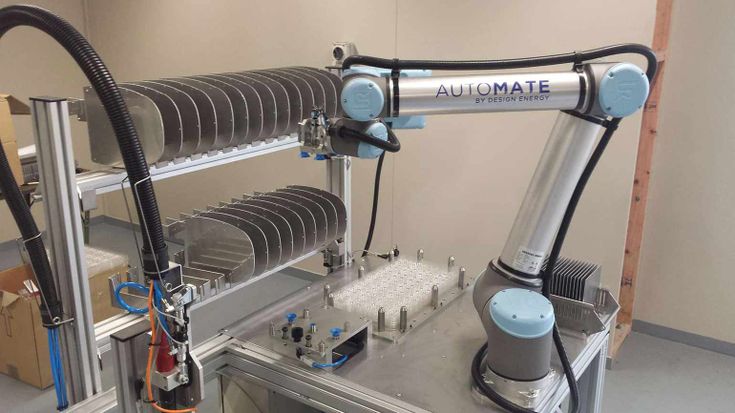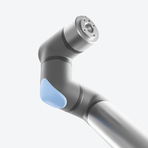Industrial robot applications have seen massive growth over the last decade, as a variety of industries have realized the potential of industrial robots and, more importantly, collaborative robot (or ‘cobots.’). The vast majority of cobot implementations are found in manufacturing and industrial environments, but cobots have the flexibility to be used in a wide variety of sectors from agriculture and medical to pharma.
Cobot Applications

Industrial robot applications have seen massive growth over the last decade, as a variety of industries have realized the potential of industrial robots and, more importantly, collaborative robot (or ‘cobots.’). Cobots are low cost industrial robots that are safe to operate in close proximity to humans. Cobots are more flexible than standard or traditional industrial robots, which means that they can be deployed on a wide variety of tasks from machine tending and welding to packaging & palletizing. The vast majority of cobot implementations are found in manufacturing and industrial environments, but cobots have the flexibility to be used in a wide variety of sectors from agriculture and medical to pharma.
With the world battling Covid-19, 2020 delivered some ingenious cobot implementations. From personal protective equipment manufacturing to swab testing, cobots are improving the efficiency, safety, and quality of countless processes. Read on to learn more about the capabilities of industrial robots in general and then we’ll look at some recent, innovative cobot applications.
What is an industrial robot used for?
There are a wide variety of industrial robot applications. Even though there are many ways to implement robotic technology, the goals of such machines are similar across all industries and processes--improved production. Robots are able to improve the efficiency and safety of many industries by assuming dull, dirty and dangerous jobs.
Traditional industrial robots are often mammoth-sized machines that are also static and difficult to repurpose and reprogram. By contrast, cobots are compact and flexible and can operate without safety cages or fencing directly alongside people.
What are the applications of cobots?
There are many collaborative robot applications across all industries. These include assembly, dispensing, finishing, machine tending, material handling, welding, material removal, quality inspections, and more. Below, we summarize three common classes of cobot deployments.
Material handling
Material handling is one of the most dangerous jobs in manufacturing. Materials such as metal, plastic and other substances can pose a great risk to human workers. Additionally, many material handling tasks are repetitive, which can give rise to repetitive strain injury.
Industries that use robots in manufacturing see significantly fewer workplace injuries. Heavy materials can easily be lifted and transported across factory floors using mobile robot platforms. Meanwhile, machine tending tasks, including those that involve heavy duty CNC machines, are also within the capabilities of Universal Robots’ cobots.
Assembly and quality assurance
Universal Robots’ cobots are specifically designed to work alongside human employees and relieve them from tedious and difficult assembly jobs. This includes welding small pieces together, drilling screws, and similar assembly tasks.
Cobots can also be used to assist with quality assurance during the production process. Unlike humans, cobots perform the same task the same way, every time, without growing tired or suffering any loss in performance. For example, cobots can place a camera in the same location for as many measurements and positions on as many work pieces as needed –all without optical recalibration.

U.S.-based contract manufacturing specialists, Comprehensive Logistics used a UR10 cobot outfitted with a vision system for engine inspection tasks. The deployment resulted in increased throughput and improved product quality.
Pick & Place tasks using cobots include adding pieces to products that are under assembly, filling boxes of completed products and stacking pallets.
Material Removal
Other tasks that are also crucial to production can be handled by cobots. For example, material removal by robots is needed for any process that involves filling molds. These small robots can assess the molded piece and take care of trimming any excess metal or plastic without damaging the part or subjecting human workers to the risk of injury.
Meanwhile, cobots fitted with dispensing tools and hardware can be used to add glue and other adhesives, while cobots fitted with a sanding kit from the UR+ platform can be used to polish pieces for a bright, smooth finish.
What are some common uses of robotic technology?
Let’s take a look at how UR cobots are used to help manufacturers in the electronic, agricultural, and pharmaceutical industries.
Electronics and technology
Universal Robots’ cobots are used by manufacturers of lighting, mobile phones, speakers, computers, and more. Because collaborative robots are easier to program than typical industrial robots, they can be programmed by non-experts and are preferred for fast implementation.
For example, New Zealand-based Betacom relies on UR10 cobots for their production of LED road lights. Producing these lights is important to ensure the safety of drivers on the road and requires a high level of precision. Using a multi-head vacuum gripper the UR10 picks a circuit board from a rack and positions it on an aluminium pressing. The robot then picks six LED lenses and locates them onto the circuit board. The final step is to pick up a pneumatic screwdriver with auto feed screws and fasten the lenses and circuit board to the aluminum pressing.

Food and agriculture
Food and agriculture production takes place round the clock. Robots are able to work 24 hours a day, which leads to less waste and faster production times compared to human labor alone. Additionally, cobots can operate in extremely hot, cold, or unpleasant conditions. As a result, more and more companies in the food production sector are turning to cobots to support human labour.

For example, Swedish food production firm Atria Scandinavia produces high-quality gourmet and vegetarian products for convenient production. Atria uses UR5 cobots to minimize downtime in their small production facility.Following the deployment, each production line at the company is able to to prepare on average 228 items per hour for delivery. “The UR robots are a great automation solution, because they can run without safety fencing. It is a significant advantage that our employees can work right next to the robots and that they easily can adjust the robots when packing different types of products," said Johnny Jansson, Atria’s Technical Manager.
Pharmaceuticals and chemicals
The production of pharmaceuticals, chemicals, and medical equipment requires the utmost precision. UR cobots are regularly used to mix, count, and dispense a variety of materials.

Copenhagen University Hospital in Denmark uses UR cobots in their lab to optimize the handling and sorting of blood samples for analysis. The solution has enabled the lab to maintain its target of delivering more than 90 per cent of results within 1 hour. Amazingly, two UR5 cobots can analyze more than 3,000 samples every day.
Which industry uses the most robots?
According to the International Federation of Robotics (IFR), the automotive industry is the largest adopter of industrial robots accounting for 28% of total installations, ahead of electrical/electronics (24%), metal and machinery (12%), plastics and chemical products (5%) and food and beverages (3%).
Vehicle production offers the most industrial robot applications because there are so many types of processes involved from assembly and machine tending to part inspection and finishing. All of these tasks –and more-- can successfully be performed by collaborative robot arms.

One of Nissan’s motor production facilities in Japan was struggling to keep up with production times and was also dealing with labor shortages and an ageing workforce. Nissan deployed two lines of UR10 robot arms to help move heavy manifolds across its production lines. It also deployed cobots alongside human employees to install engine intakes and loosen bolts.
What are some novel cobot applications?
The above examples are all common applications for cobots in industry. However, thanks to the flexibility, ease of deployment and range of capabilities offered by cobots, end users continue to discover creative ways to improve their processes. In 2020, the challenges posed by Covid-19 generated some ingenious new implementations of cobots. In April, for example, a team at the University of Southern California (USC) revealed its prototype Agile Dexterous Autonomous Mobile Manipulation System-UV (ADAMMS-UV). The system incorporates a UR5 cobot mounted on a mobile platform. It uses a UV light wand with an additional UV light source mounted on the base, to break down coronavirus DNA.
Elsewhere, Lifeline Robotics, a company founded by Universal Robots co-founder Esben Østergaard, in collaboration with robotics researchers from the Maersk Mc-Kinney Moller Institute at the University of Southern Denmark developed a cobot-based system for safe and effective Covid-19 testing. The solution, which launched at the end of May 2020, takes 7 minutes for the entire testing process and is the world’s first autonomous throat swabbing robot.
Meanwhile, Gamber-Johnson, a supplier of mounting systems for mobile communication systems, computers and other electronic equipment located in Wisconsin, USA, joined a collaboration with local partners to create a temporary face shield production facility. At the heart of the facility is a UR5 cobot, which is used to cut out plastic sheets for face shields. Gamber-Johnson and partners crowdsourced funds and have raised thousands of dollars for producing face shields to donate to local area hospitals.
When COVID-19 reached Portland, USA, traffic at the popular In J Coffee coffee shop dropped by 50%. Owner Joe Yang understood that customers were concerned about human contact and viral spread so he decided to build a cobot barista. The end result is a completely contact-free, cobot-powered system for preparing specialty coffee. Dubbed 'Jarvis,' the cobot is able to make coffee, froth milk and can even pour latte art.

To find more examples of how cobots have helped in the battle against Covid-19 check out the Universal Robots blog, which covers the topic in more depth: here, here and here.
Universal Robots cobots are versatile automation platforms that can be used for a huge range of tasks from grinding and polishing to machine tending, blood testing, food packaging and even making coffee!
Unlimited Possibilities
These are just a few of the unique applications for cobots. The future of manufacturing and production industries will undoubtedly see further novel applications of collaborative automation systems. No matter where your company is headed, UR cobots can help you achieve your goals.
Interested in finding out more about cobots? Talk to one of our experts here!

- Universal Robots USA, Inc
- 27175 Haggerty Road, Suite 160
- 48377 Novi, MI